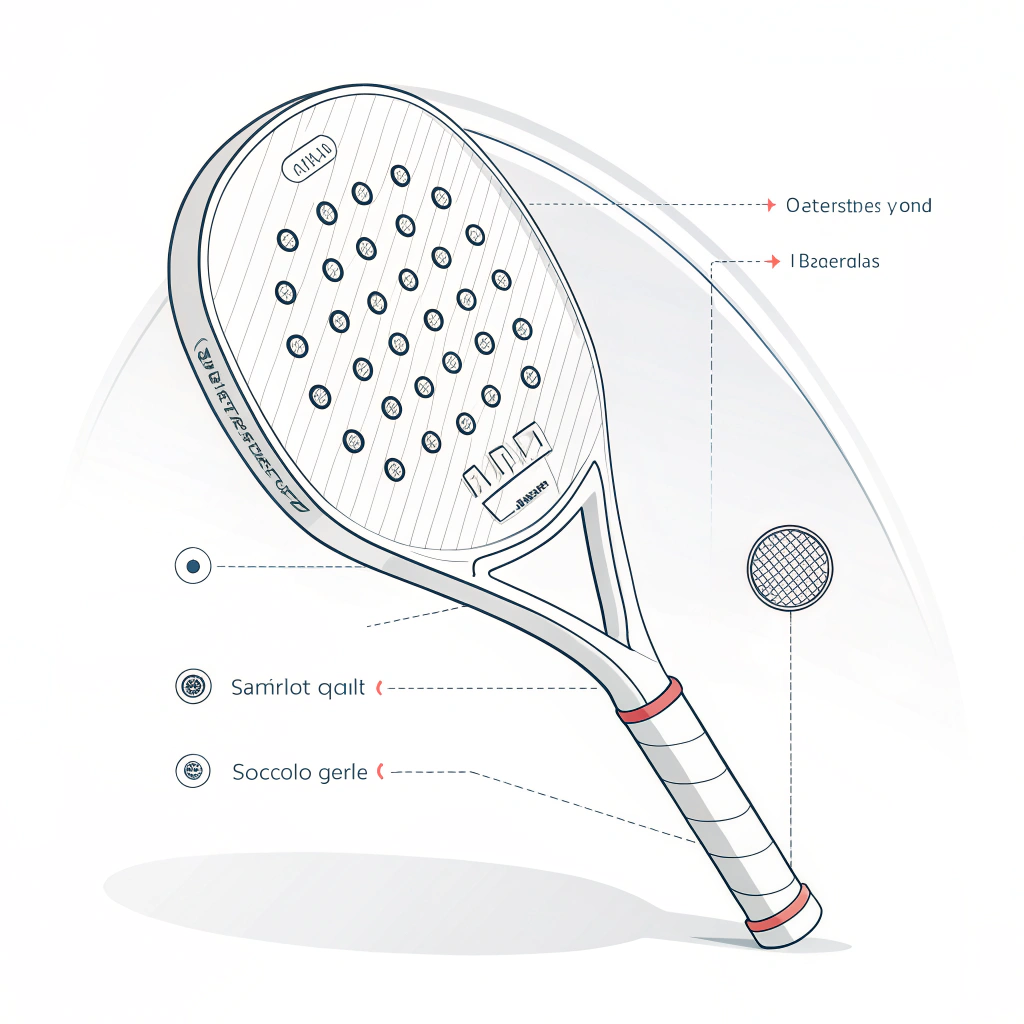Fast answer: An ergonomic grip1 on a padel racket is not just an accessory but a strategic performance enhancer that minimizes player fatigue, boosts control, and ultimately drives higher on-court performance, making it an essential feature for competitive padel equipment.
In today’s competitive padel market, bat manufacturers are constantly innovating to combine technology and design. One of the most influential yet often underrated innovations is the ergonomic grip. An ergonomic design is aimed at reducing strain and improving comfort while still ensuring precision handling. For B2B purchasers, an investment in padel rackets featuring ergonomic grips can directly contribute to enhancing customer satisfaction and driving sales conversion.
Padel players frequently deal with discomfort and fatigue during extended play, primarily due to poorly designed grips that can lead to slippage, uneven pressure distribution, and repetitive strain injuries. Traditional grips often lack anatomical support, leading to issues such as:
• Reduced player performance due to hand fatigue
• Increased risk of injuries like carpal tunnel syndrome
• Overall dissatisfaction among amateur and professional players
The dissatisfaction is not only noticeable in player performance but also reflects in lower customer retention and repeat purchases for retailers. When the grip fails to provide a secure and comfortable hold, the entire play experience suffers.
Recent design innovations in ergonomic grips involve advanced materials and custom fitting technology. The integration of technical design2 elements means that each component—from cushioning to the grip’s contour—plays a pivotal role in performance enhancement. Key benefits include:
• Enhanced Control & Precision: Ergonomic grips support a natural hand position which improves racket maneuverability.
• Injury Prevention: Proper cushioning and design reduce the risk of strain and overuse injuries.
• Improved Durability: High-performance materials such as carbon fiber3 composites combined with advanced soft-touch polymers sustain prolonged usage.
• Customization4: Options for personalized printing, color, and logo placement allow brand differentiation.
For manufacturers like NEX Padel, such advanced features align with both performance enhancement and product differentiation in the competitive padel market.
Ergonomic grips are a result of meticulous design and material selection. Here are the key aspects that contribute to their improved performance:
- Anatomical Contours: The grip is contoured to match the natural curves of the hand. This design minimizes points of excessive pressure, promoting even load distribution.
- Soft-Touch Materials: Incorporating materials such as high-density foam overlaid with carbon fiber fibers (available in 3k, 12k, or 18k grades) provides an ideal balance between stiffness and softness.
- Absorptive Properties: Many ergonomic grips come with moisture-wicking surfaces. This helps maintain a firm grip even under sweaty conditions, enhancing play performance.
- Customization: Custom options for colors, prints, and logo placements enable retailers to offer rackets that reflect their brand identity.
At NEX Padel, premium manufacturing processes ensure that every padel racket meets strict quality standards. Our advanced techniques include rapid prototyping5 and quick sampling, which confirm product integrity at every stage. The use of different carbon fiber grades is particularly noteworthy. For instance, using 18k carbon fiber in the hand grip region can significantly improve both strength and durability while maintaining a lightweight feel. This high-grade material absorption capacity and excellent stress distribution translate into clear performance advantages on the court.
A detailed table below outlines some production benefits relative to grip materials:
| Material Grade | Benefits | Applications |
|---|---|---|
| 3k Carbon Fiber | Lightweight, cost-effective | Entry-level rackets |
| 12k Carbon Fiber | Enhanced durability and improved stiffness | Mid-tier performance |
| 18k Carbon Fiber | Superior strength with highly refined grip feel | High-performance models |
This table provides a glance at how material selection impacts both performance and cost efficiency—key points that B2B purchasers need when assessing product portfolios.
For product buyers and purchasing managers, transitioning to ergonomic grip-equipped padel rackets can be mapped out through the following actionable steps:
-
Evaluate Current Product Line:
Review the performance of current rackets and identify if grip-related issues are frequently reported. -
Market Analysis:
Investigate market trends emphasizing ergonomic enhancements. This aligns with consumer demand for products that ensure long-term play comfort and visible performance gains. -
Supplier Collaboration:
Engage with manufacturers who prioritize advanced production techniques. NEX Padel is recognized for rapid prototyping and quality quality control across all aspects of racket design. -
Technical & Aesthetic Customization:
Consider the design flexibility offered by modern manufacturing processes. With options for custom printing, diverse carbon fiber applications, and personalized color schemes, it's possible to meet both technical and branding requirements. -
Trial and Testing:
Before a full-scale product launch, conduct field tests among target demographics. Use feedback to refine ergonomic designs further. -
Marketing and Communication Plan:
Highlight the ergonomic benefits and technical innovations in your sales and marketing communications. Educate end-users about the tangible benefits of ergonomic grips, such as reduced fatigue and enhanced control.
By following these steps, companies can reduce common grip-related issues and enhance overall player satisfaction, leading to improved sales metrics in the competitive padel market.
A comparative perspective further illuminates the value offered by ergonomic grips. The following points highlight major differences:
| Feature | Traditional Grips | Ergonomic Grips |
|---|---|---|
| Design Alignment | Generic, one-size-fits-all | Anatomically designed for natural hand comfort |
| Material Quality | Basic cushioning without advanced polymers | High-density foam with carbon fiber composites |
| Customization Options | Limited colors and branding opportunities | Fully customizable prints, colors, and logos |
| Player Comfort | Prone to causing hand fatigue during prolonged play | Reduces fatigue, provides stabilized handling |
| Durability | May wear out quickly in high-stress usage | Engineered for longevity and sustained performance |
This table provides a clear illustration of why ergonomic grips are becoming the preferred choice in high-performance padel racket manufacturing. Retailers can use these comparisons as a selling point, emphasizing technical superiority and enhanced player experience.
Data-driven decision-making is crucial for B2B purchasers, and several case studies underline the efficacy of ergonomic grips:
• A European padel retail chain reported a 20% increase in customer satisfaction metrics after transitioning to rackets featuring ergonomic grips.
• In performance tests, players using ergonomic grips exhibited improved shot accuracy and longer play durations with less fatigue.
• Quantitative feedback from players noted a significant decrease in wrist and elbow strain, which directly correlated to enhanced on-court performance.
Our partnership with brands such as Hirostar and Reebok has consistently shown that improved design—particularly in grip ergonomics—can distinguish products in a competitive sports equipment market.
While ergonomic grips offer notable benefits, it is important to be aware of some considerations when integrating such technologies into your product portfolio:
-
Cost Implications:
Upgraded materials and advanced production techniques may slightly increase the cost at the manufacturing stage. However, the benefits in terms of enhanced player performance and reduced injury rates can justify this investment over time. -
User Adaptation:
Some players accustomed to traditional grips might require time to adjust to the new feel of an ergonomic design. Market education and trial opportunities can help ease this transition. -
Regional Preferences:
Consumer preferences can vary by region. It is essential to conduct localized market research to ensure that ergonomic features align with customer expectations. -
Production Scalability:
Rapid scaling while maintaining uniform quality can be challenging. A close partnership with a manufacturer experienced in high-performance sports equipment, like NEX Padel, is key to overcoming these challenges.
Understanding these factors is vital for making informed purchasing decisions that can benefit both the retailer and the end user.
In summary, ergonomic grips are not just a simple modification but a transformative feature in padel racket design. They enhance player comfort by conforming to the hand’s natural structure, reduce the risk of fatigue and injury, and offer significant performance upgrades critical for competitive play.
For sports equipment purchasing managers and product buyers evaluating products for padel specialty retailers, here are the main action points:
• Prioritize high-performance materials such as carbon fiber3 in grip construction.
• Ensure a balance between cost and technology through detailed supplier assessments and field tests.
• Invest in products that differentiate through critical performance enhancements like ergonomic grips.
• Use data and case studies to empower your purchasing decision, knowing that improved ergonomics lead to happier players and repeat business.
NEX Padel’s commitment to quality is evident in our advanced production techniques and rapid prototyping capabilities. By offering customizable padel rackets featuring ergonomic grips, we provide a competitive edge that meets both technical requirements and market demands. This innovation positions our partners for success in an increasingly competitive sports equipment landscape.
In the rapidly evolving world of padel, enhancing equipment performance through ergonomic innovation is more than a trend—it is a necessity. Early adopters and strategic B2B purchasers who recognize these benefits can expect improved product appeal, higher customer satisfaction, and sustained market growth. Now is the time to upgrade your product portfolio with advanced ergonomic solutions to stand out from the competition.
Q: What are the benefits of ergonomic grips on padel rackets?
A: Ergonomic grips enhance player comfort through anatomical design, reduce hand fatigue, improve precision, and lower the risk of injuries, all while providing options for customization and superior durability.
Q: How do ergonomic grips compare to traditional grips in padel rackets?
A: Ergonomic grips offer significant advantages over traditional grips by aligning with the natural hand shape, using high-quality cushioning materials, and incorporating customization features that enhance overall performance and user satisfaction.
Q: Can menstrual ergonomic grips really improve gameplay performance?
A: Yes, ergonomic grips minimize strain by evenly distributing pressure, which results in better control, longer play duration, and reduced fatigue, ultimately contributing to improved on-court performance.
-
Ergonomic grip: Reading this article will help you understand how ergonomic grip designs minimize player fatigue and boost overall performance on the court. ↩ ↩
-
Technical design: Learn about the role of technical design in developing high-performance sports equipment and how it contributes to enhanced usability and durability. ↩ ↩
-
Carbon fiber: Discover the benefits, properties, and applications of carbon fiber in sports equipment manufacturing, including its strength, light weight, and durability. ↩ ↩ ↩2
-
Customization: Explore how offering customization options like personalized printing and color variations can differentiate products and cater to specific market needs. ↩ ↩
-
Rapid prototyping: Understand how rapid prototyping accelerates product development and ensures quality control in manufacturing processes. ↩ ↩







